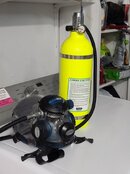Well that's one thing mine can't do as there is no knob on the valveulator.The slung pony also has the significant advantage that if the second stage were to screw up and start freeflowing, the bottle MAY still be usable by manually feathering the bottle on and off for each inhalation cycle on the ascent.

The FFM was on there because I was going to wear it to publix with my drysuit at one point. Then I decided that it might upset some folks so I never did it. Obviously I don't really carry it with a FFM. The point of the photo is to show the lack of a valve handwheel. If it's full of gas, it's on. I kind of like it that way.



